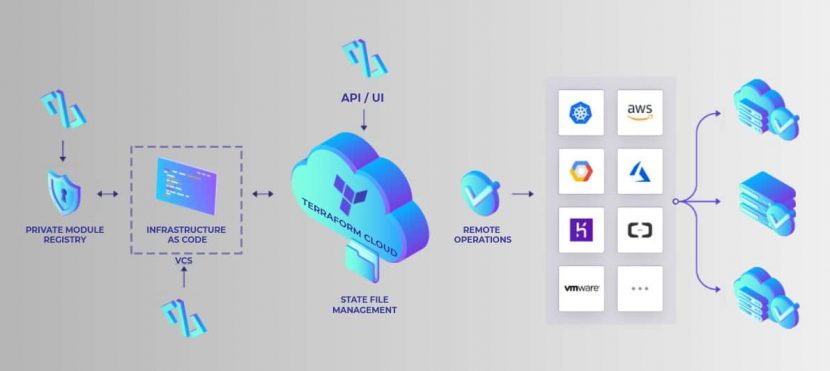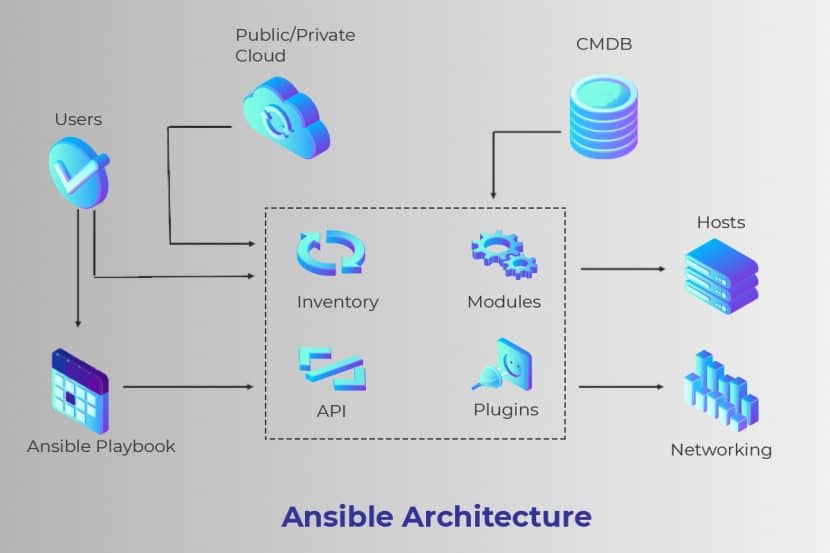Background of Terraform and Ansible
- Terraform (released 2014): Hashicorp developed Terraform as an infrastructure orchestrator and service provisioner. It is cloud-agnostic, supporting several providers. As a result, users can manage multi-cloud or multi offering environments, using the same programming language and configuration construct. It utilizes the Haschorp Language and is quite user-friendly as compared to other tools.
- Ansible (released 2012): Ansible is a powerful tool used to bring services and servers into the desired state, utilizing an assortment of classes and configuration methods. Additionally, it can also connect to different providers via wrapper modules to configure resources. Users prefer it because it is lightweight when coding is concerned, with speedy deployment capabilities.
Understanding Terraform
Developed and offered by HashiCorp, Terraform is an open-source Infrastructure as Code that allows users to manage cloud services through a language named HashiCorp Configuration Language (HCL). Currently, Terraform supports 200 providers, including public cloud, private cloud, and SaaS providers.
In Terraform, the final state is defined directly. The only drawback is that as Terraform is declarative in nature, the final result is accessible only to providers. Therefore, if users need to access the end state, then they must install and configure the deployed applications using the scripts and tools.
Along with initial deployment, Terraform also performs orchestration. This functionality is possible because of its:
- Execution plans: Users can specify the steps to be performed, along with the order of execution.
- Resource graphs: Users can visualize the plan, which is much more than the performance of Ansible.
Terraform code is efficient enough in spinning up the environments; hence, it quickly describes the resources that make up a stack.
When we make a comparison as Ansible vs Terraform, we get to know that Terraform works great in automating provisioning processes and also aids in the process of moving to cloud management resources.
The main difference between Terraform and Ansible is that Terraform is declarative in defining the process by which results can be achieved. While using Terraform, code always represents the present status of the infrastructure.
- Terraform consists of a command-line interface that can provide infrastructure in a simple code.
- It can efficiently perform building, versioning, and altering the infrastructure.
- It is excellent in managing cloud services.
- Terraform offers flexibility in managing service providers and in-house solutions.
- It can also manage low-level instances, such as storage and networking, along with high-level instances, like SaaS and DNS.
- It consists of built-in parallel mechanisms.
- Terraform supports several providers. Therefore, a user can handle multi-cloud environments using the same language.
Features of Terraform
- Deploy IaC: Terraform quickly deploys Infrastructure as Code, due to which environment installation and development is faster with Terraform.
- Modular approach: This approach uplifts consistency and collaboration. Using this feature, functionality can be easily shared and reused across all deployments.
- The graph command: Terraform graph command executes the modeling of relationships.
Terraform is quick to build from scratch as compared to other tools. It can be used to build anything, be it creating a cloud network, scaling objects, or providing pretty much every cloud feature.
Understanding Ansible
Ansible has been run by Red Hat Inc. since 2012. It is a configuration management tool with a core open-source project. However, a few commercial extensions, like Ansible Tower, are also available. Ansible’s architecture is agentless and serverless, and it supports modules for managing Windows and UNIX-like hosts. It depends on SSH/PowerShell sessions for conducting the configuration tasks.
Ansible executes an imperious DevOps paradigm. As a result, its users are solely considered responsible for executing all the ad-hoc commands and steps that go into achieving the desired goal. The essential tasks here include:
- Writing instructions on the way to install applications
- Design the templates of configuration files
Because of its imperative nature, Ansible is perfectly suitable for traditional configuration management. It is used for various purposes, such as automation and potential migration. However, Ansible is inefficient in orchestrating services and in scaling large environments of interconnected applications.
Ansible is a popular automation tool used for deploying codes and servers. Due to its configuration methodology, Ansible can help track the changes made and bring servers and services within the desired state.
Features of Ansible
- Agentless: This is the biggest advantage of Ansible. Being agentless, it diminishes the efforts involved in installing and managing an agent.
- Re-entrant: This is a notable feature added in Ansible, which lessens the effort that goes into script re-entrant. You just need to re-run Ansible, and your problem gets fixed!
- Infrastructure as Code: It acts as a single tool for all DevOps tasks as it defines the infrastructure in the Ansible playbook and commits to source control.
Ansible is a light-weight tool preferable for quick deployment abilities. Moreover, it is user-friendly to begin with. You can perform the complete management of your servers with just a little configuration.
When you make a comparison as Terraform vs Ansible, Ansible excels in the process of configuring systems as it follows the step-by-step process in achieving the end result.
Ansible consists of numerous popular sub-modules, such as AWS and Azure, to be able to support integrations. This configuration management tool is perceived as a hybrid tool as it can execute a procedural-style configuration.
Comparing Provisioning
Automating the provisioning of any infrastructure is the first step in the automation of an entire operational lifecycle of an application and its deployment. In the cloud, the software runs from a VM, Docker container, or a bare metal server. Either Terraform, or Ansible is a good choice for provisioning such systems. Puppet is the older tool, so we’ll take a closer look at the newer DevOps programs for managing multiple servers.
Terraform and Ansible approach the process of provisioning differently, as described below, but there is some overlap.
Provisioning with Terraform:
There are certain behaviors not represented in Terraform’s existing declarative model. This setup adds a significant amount of uncertainty and complexity when using Terraform in the following ways:
The Terraform model is unable to model the actions of provisioners when it is part of a plan. It requires coordinating more details than what is necessary for normal Terraform usage to use provisioners successfully.
It requires additional measures such as granting direct network access to the user’s servers, installing essential external software, and issuing Terraform credentials for logging in.
Provisioning with Ansible:
Ansible can provision the latest cloud platforms, network devices, bare metal servers, virtualized hosts, and hypervisors reliably.
After completing bootstrapping, Ansible allows separate teams to connect nodes to the storage. It can add them to a load balancer, or any security patched or other operational tasks. This setup makes Ansible the perfect connecting tool for any process pipeline.
It aids in automatically taking bare infrastructure right through to daily management. Provisioning with Ansible, allows users to use a universal, human-readable automation language seamlessly across configuration management, application deployment, and orchestration.
Differences between Ansible and Terraform for AWS
AWS stands for Amazon Web Services, a subsidiary of Amazon, which provides individuals, companies, and business entities on-demand cloud computing platforms. Both Terraform and Ansible treat AWS management quite differently.
Terraform with AWS:
Terraform is an excellent way for users who do not have a lot of virtualization experience to manage AWS. Even though it can feel quite complicated at first, Terraform has drastically reduced the hurdles standing in the way of increasing adoption.
There are several notable advantages when using Terraform with AWS.
- Terraform is open-source, bringing with it all the usual advantages of using open-source software, along with a growing and eager community of users behind it.
- It has an in-built understanding of resource relationships.
- In the event of a failure, they isolate to dependent resources. Non-dependent resources, on the other hand, continue to be created, updated, and destroyed.
- Terraform gives users the ability to preview changes before being applied.
- Terraform comes with JSON support and a user-friendly custom syntax.
Ansible with AWS:
Ansible has offered significant support for AWS for a long time. This support allows interpretation of even the most complicated of AWS environments using Ansible playbooks. Once described, users can deploy them multiple times as required, with the ability to scale out to hundreds and even thousands of instances across various regions.
Ansible has close to 100 modules that support AWS capabilities. Such as Virtual Private Cloud (VPC), Simple Storage Service (S3), Security Token Service, Security Groups, Route53, Relational Database Service, Lambda, Identity Access Manager (IAM), AMI Management and CloudTrail to name a few. Also, it includes over 1300 additional modules for managing different aspects of a user’s Linux, Windows, UNIX, etc.
Here are the advantages when using Ansible with AWS.
- With Ansible Tower’s cloud inventory synchronization, you will find out precisely which AWS instances register despite no matter how they launched.
- You can control inventory by keeping track of deployed infrastructure accurately via their lifecycles. So, you can be sure systems manage properly, and security policies execute correctly.
- Safety in automation with its set of role-based access controls ensuring users will only have access to the AWS resources they need to fulfill their job.
- The same simple playbook language manages infrastructure and deploys applications on a large scale and to different infrastructures easily.
Comparison of Ansible and Terraform
| Point of Difference | Ansible | Terraform | |
| Management and Scheduling | In Ansible, instantaneous deployments are possible because the server pushes configurations to the nodes. When it comes to scheduling, Ansible Tower, the enterprise version, has the capabilities while it is absent in the free version. | In Terraform, resource schedulers work similarly as providers enabling it to request resources from them. Thus, it is just not limited to physical providers such as AWS, allowing its use in layers. Terraform can be used to provision onto the scheduled grid, as well as setting up the physical infrastructure running the schedulers. | |
| Ease of Setup and Use | Ansible is simpler to install and use. It has a master without agents, running on the client machines. The fact that it is agentless contributes significantly to its simplicity. Ansible uses YAML syntax, written in the Python language, that comes built-in most Linux and Unix deployments. | Terraform is also simpler to understand when it comes to its setup as well as usage. It even allows users to use a proxy server if required to run the installer. | |
| Availability: | Ansible has a secondary node in case an active node falls. | Not Applicable in Terraform’s case. | |
| Scalability: | Scalability is easier to achieve | Scalability is comparatively easily achieved | |
| Modules | Ansible’s repository or library is called Ansible Galaxy. It does not have separate sorting capabilities and requires manual intervention. | In Terraform’s case, modules allow users to abstract away any reusable parts. These parts can be configured once and can be used everywhere. It thus enables users to group resources, as well as defining input and output variables. | |
| GUI | Less developed is Ansible’s GUI, first introduced as a command-line only tool. Even though the enterprise version offers a UI, it still falls short of expectations suffering from syncing issues with the command-line. | Only third party GUIs are available for Terraform. For example, Codeherent’s Terraform GUI. | |
| Support | Ansible also includes two levels of professional support for its enterprise version. Additionally, AnsibleFest, which is a big gathering of users and contributors, is held annually. The community behind it is smaller when compared to Puppet. | Terraform provides direct access to HashiCorp’s support channel through a web portal. |
Final Note 😎
Terraform was designed with immutability in mind. It is a provisioning tool that deals with immutable infrastructures in a native way. This makes it a good choice when you reject configuration management tools. The tool is more intuitive for infrastructure orchestration because it was created for it and all of its updates are dedicated to that.
Ansible is optimized for configuration management and although it can perform orchestration tasks it is better to use the best (and fastest) tool for the given task.
Terraform and Ansible have their fair share of similarities, along with some dissimilarities. Both tools help in deploying code and infrastructure in repeatable environments that possess complex requirements. However, if you take a practical approach, it is advisable to use Terraform for the purpose of orchestration and Ansible for configuration management.
As day by day data centers are increasing in their complexity, each of these tools finds its space in the development process. Nevertheless, you should be aware of the limitations of both before employing them in your workforce.





